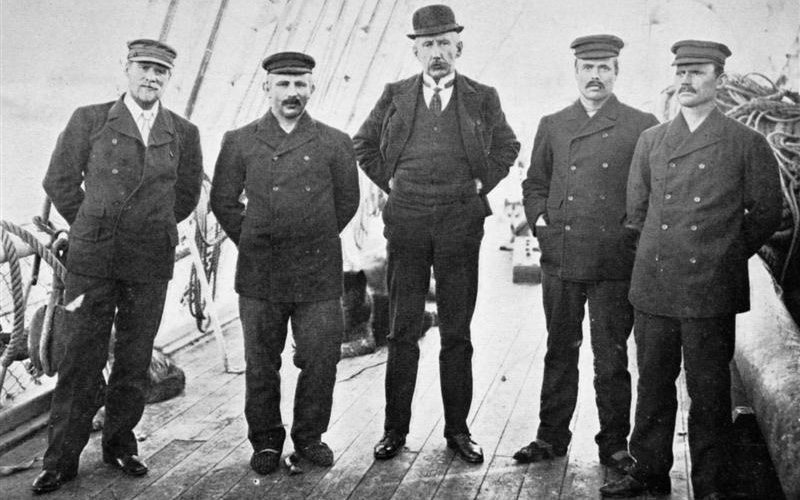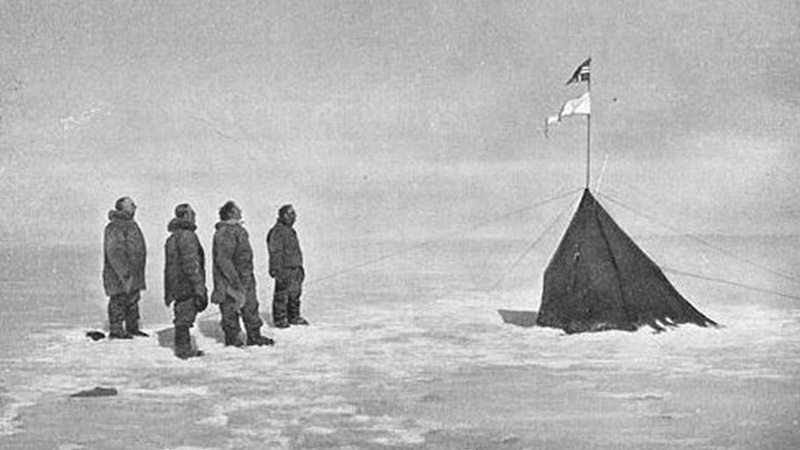Roald Amundsen (1872–1928)
Episode #10 of the course “Europe’s greatest explorers”
Roald Engelbregt Gravning Amundsen was a Norwegian explorer who dedicated his life to the exploration of dangerous and uncharted territories. He was the first person to navigate the North American Northwest Passage, the first person to reach the South Pole, and the leader for the air expedition to the North Pole as well.
Amundsen is one of the most well-known explorers active during the “Heroic Age of Arctic Exploration,” when several daring men competed for the rights and honor of being the first European to set foot on different uncharted regions throughout the Arctic (North Pole) and Antarctic (South Pole). One of his fiercest competitors was Robert Falcon Scott. The two men would bury bottles with messages for one another at different geographic landmarks as a way of marking victory over the other.

Members of the party who reached the South Pole. From left- Hassel, Wisting, Captain Amundsen, Bjaaland, Hanren
Born into a seafaring family, young Roald Amundsen promised his mother he would attend a university rather than pursue life at sea. She died when he was 21, and he promptly quit school to pursue his dream of charting the world’s wildernesses. After four years as a sailor, he served as first mate on the Belgian Antarctic Expedition. The expedition’s ship became locked in ice, causing Amundsen to gain the distinction of being one of the first people to ever spend a winter in Antarctica.
In 1903, Amundsen led a crew of six men on a trek to fulfill his boyhood dream: find and chart the fabled Northwest Passage. It took three years, including harsh winters, but Amundsen and his crew finally maneuvered their way from the Atlantic to the Pacific around the north side of North America.
Amundsen then turned his attention in 1911 to another prize: locating and marking the magnetic South Pole. The journey was treacherous—more than 800 miles from their base camp. However, he did become the first person to reach Earth’s South Pole, and today the Amundsen-Scott South Pole Station is named in honor of the explorative efforts of both men.
During World War I, Amundsen profited as a trader and completed less daring treks into the wilderness. He was the second person to complete a northeast passage around Siberia in 1920, and he increasingly became more interested in using airplanes for exploration rather than navigating ships.
Amundsen made a number of valuable improvements to equipment used in extreme (especially polar) conditions. He used tricks learned from the indigenous Netsilik Inuits, who had adapted to live in the harsh environment. He and his crew became skilled masters of sled dog teams, learned to layer furs for warmth, and adapted the use of ice caves and igloos.
In 1926, Amundsen completed the first trans-arctic flight in an airship directly across the North Pole, from Spitsbergen, Norway, to the Inuit village of Teller, Alaska. Enjoying his fame and satisfied with the extent of his discoveries, Amundsen retired. In 1928, he was recruited to assist with a rescue mission for a stranded arctic team whose airship had crashed. Amundsen was a passenger on a plane that never returned. It is assumed they crashed and died because of fog on the Barents Sea.
Recommended book
“The Last Viking: The Life of Roald Amundsen” by Stephen R. Bown
Share with friends


